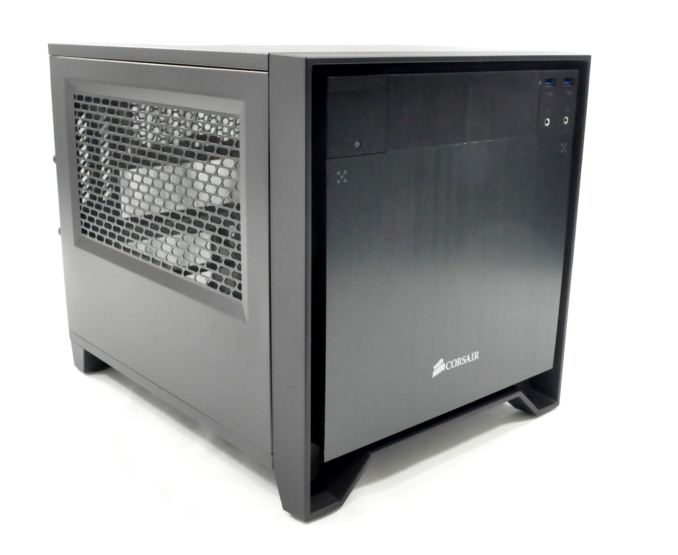Corsair Obsidian 250D Case Review
by E. Fylladitakis on January 21, 2014 12:00 PM EST- Posted in
- Cases/Cooling/PSUs
- Corsair
- Mini ITX
- Case
Corsair Obsidian 250D Exterior
Externally, the Obsidian 250D can be easily described as the cubic variation of the Obsidian 350D, the micro ATX case that Corsair introduced last April. The Obsidian 250D is 16 cm shorter and 9 cm less deep as its larger micro ATX brother, yet it is about 7 cm wider. As a result, even though the case is shorter and not as deep, the volume of the case is reduced by about 30% (≈0.028 cubic meters against the ≈0.042 cubic meters of the Obsidian 350D). Although Corsair has not officially disclosed the weight of the Obsidian 250D, the sample that we received tipped the scales at about 5 kg, which is about half the weight of an average simple ATX tower case.
Corsair went with a modern, post-minimalistic design with the Obsidian 250D. It is a case of clean lines and basic geometric shapes, with an addition of a top panel window and a brushed aluminum fascia with the company logo imprinted on it. The frame of the case and the side/top panels are made out of 1 mm SECC steel, while the front panel is made out of 2 mm thick plastic. The front panel also forms the two front feet of the Obsidian 250D, while the rear plastic feet are each attached to the metallic chassis. Considering the size of the case, the feet are quite tall, elevating the metallic frame of the Obsidian 250D about 2 cm above the surface. The aluminum front covers are no more than thin sheets of metal attached to the plastic frame beneath them and have been added for aesthetic purposes only.
Two USB 3.0 ports and two 3.5" audio jacks (headphones, microphone) can be found at the top right side of the aluminum fascia. The top right side is also home to a tiny circular reset button and the power on button, a ≈4 cm long stripe with the two case LED lights (power and HDD activity) integrated inside it. In between the buttons and the front I/O ports, there is a single 5.25" bay for an optical device.
The rest of the aluminum fascia actually is a large door, which can be opened by applying pressure to both of the top corners simultaneously. Once opened, the door will lean forward by about 45 degrees, giving direct access to the intake fan filter behind it, making cleaning of the front filter a trivial procedure.
Both side panels of the Obsidian 250D have large openings with integrated fan filters. Cleaning these fan filters will unfortunately not be as easy as the front filter, as the panels will have to be removed in order to access them. Both openings are about 280 mm wide by 140 mm high, with the right side panel opening right next the exhaust fan(s) or liquid cooler radiator and the left side panel opening right next to the intake of the GFX card fans. This design allows a powerful GFX card to draw cool air directly from the exterior of the case, which will definitely improve its thermal performance; however, it can also backfire if the user is far too negligent, as the filter could gather so many particles that it may become entirely clogged, leaving almost no space for the GFX card cooler to draw air from. This does not mean that the filters of the case require cleaning too frequently; depending on the environment, the filters may require cleaning anywhere between some weeks and up to several months.
The rear side of the Obsidian 250D is rather interesting, because it not only illustrates the internal design of the case but also gives access to the installation of disk drives and the PSU. The Obsidian 250D is split into two compartments; the bottom half is home to the HDD cage and the PSU partition, while the top half is meant to hold the main system, with the motherboard placed horizontally. Obviously, the orientation of the motherboard is why the window has been installed on the top panel of the case as well.



















52 Comments
View All Comments
Gadgety - Thursday, January 23, 2014 - link
Looks good for watercooling, as does the build quality and dust filters. I also like the 200mm fan possibility. For a marginally larger case, for example the Lian-Li V-360, or the Prodigy M, one can fit mATX. Could Corsair have gone with a mATX version as well? For MITX and air cooling, the Lian-Li PC-Q33 looks pretty good. I can host an 18 cm tower cooler, and 5 disks in a chassi which is 60% the size of this one. No optic disk, and no dust filters though.Broo2 - Friday, January 24, 2014 - link
Great review. I heard about this case a few weeks ago and this is one case I have been considering it for a small PC. This review has definitely helped my decision making process. :)